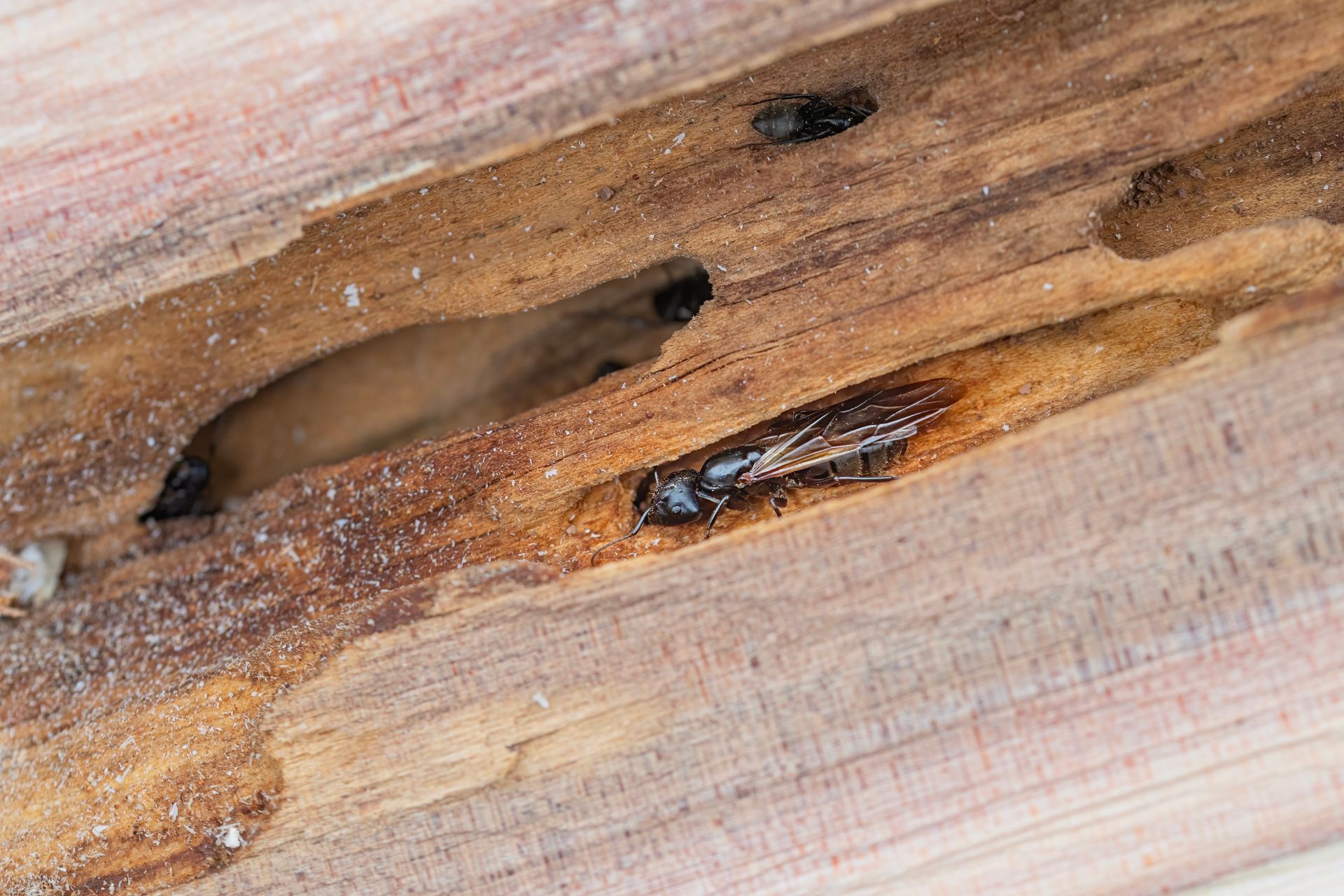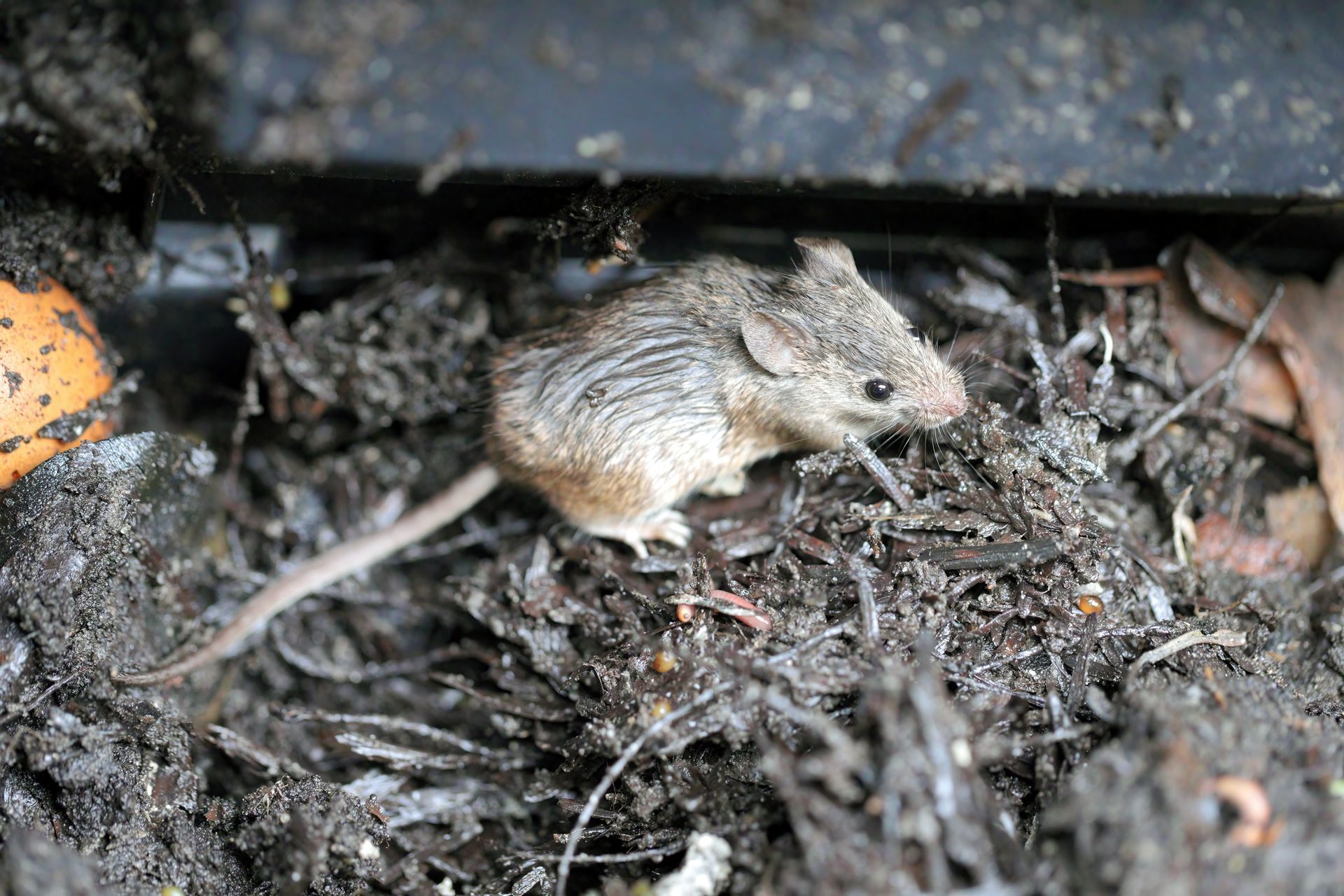Common Signs of Carpenter Ant Damages

Carpenter ants are a wood destroying insect that can cause a significant amount of damage if their presence isn’t noticed right away. Be sure to look for common signs of carpenter ant activity to ensure that your property can be treated as soon as carpenter ants are noticed. Signs like large black ants crawling in and out of the wooden structures of your home, small entry holes into open wooden surfaces, piles of sawdust, or deteriorating wood filled with hollowed out galleries are all common indicators of the presence of carpenter ants. These signs are similar to other wood destroying insects, but carpenter ants are particularly damaging because their colonies can get so big that they expand and create satellite colonies. When this happens, treating for carpenter ants can get complicated because multiple colonies will need to be treated for the problem to be fully exterminated.
Do Carpenter Ants Eat Wood?
Carpenter ants burrow into damaged wood by tearing off little pieces of the wood with their mandibles. They do so in order to create hollow galleries inside the wood that they can fill with eggs and larvae. It is important to note that carpenter ants only destroy wood but they don’t actually eat the wood like termites do. Carpenter ants prefer to eat sugary substances or proteins which means that carpenter ants’ diet consists primarily of trash and other bugs.
Warning Signs of Carpenter Ant Damage
Carpenter ant damages are extremely similar to signs of termite damage, so it is important to know the difference between the types of wood damage.
Presence of Carpenter Ants
The most obvious sign of carpenter ants is to see them actively moving in and out of the wooden structures of a home. This can only be carpenter ants because other ant species live underground in colonies. Carpenter ants are also larger than your average ant species with adults reaching up to a ½ inch long. This makes them the largest North American ant species which makes identification easier.
Carpenter Ant Frass
Carpenter ants shred wooden structures to create access points and hollow spaces for their colonies. In doing so, carpenter ants create wooden shavings as a byproduct of their destruction. This sawdust is known as carpenter ant frass. This frass often contains insect parts, carpenter ant poop, and little pieces of other building materials. It is important to note that carpenter ant frass isn’t always easily seen or in a place where it will be discoverable. Often times, carpenter ant frass will end up inside wall voids, crawl spaces, or other hard to reach places which make it near impossible to notice right away.
Carpenter Ant Holes
Another indicator of carpenter ant activity are the access holes that they create to get into damaged wood. These holes are known as kickout holes and they are created with the intent of allowing carpenter ants to move freely as well as a place for carpenter ants to “kick out” any debris they don’t want inside the nest. These holes are typically not much larger than the ants themselves so they may be difficult to discover without careful inspection. They are sometimes easier to spot when a kickout hole has a small pile of frass that has piled up right below the exit hole.
Visible Carpenter Ant Tunnels and Damage
Carpenter ant damage is largely under the surface of a wooden structure where they are most likely to stay protected. This means that carpenter ant damage is rarely visible until it is far too late. That being said, when carpenter ant damage is severe, it may cause the wooden structures of a home to deteriorate which can expose the underlying damages caused by carpenter ants. This usually results in tunnels and hollowed out cavities within the wood where carpenter ant eggs and larvae are often held. When this type of damage is exposed, the damaged surfaces will appear to be sanded down which is an indication of carpenter ants.
Faint Sound of Movement Inside Walls
Carpenter ant colonies that have grown to a decent size will cause a lot of movement inside the wooden structures they inhabit. This movement will create light rustling noises that seem to come from the wood. This noise will be difficult to detect if there’s a lot of noise but pressing your ear up against the wall should help amplify the sound.
Is it a Carpenter Ant or Termite Damage?
Since carpenter ants and termites both damage wood, it can be difficult to determine which insect is responsible for the damage. The damage caused by both bugs share a lot of similarities in appearance but there are key differences between the two that help identify which bug is responsible for the damages. One key indicator is the appearance of the wooden byproduct created by the two insects as they destroy the wood. Termites are one of the few creatures that can actually process and digest cellulose which means that termites eat the wood and excrete wooden pellets called termite frass. These tiny pellets are oval shaped and look like ground pepper. Carpenter ants on the other hand, tear little pieces of wood off which results in a sawdust like powder. Carpenter ant frass will also contain part of other bugs, carpenter ant excrement, and other shredded building materials.
Carpenter ants also create a polished surface that looks like it was sanded down where as termites tend to leave much more abrasive surfaces in their wake. Carpenter ants are also meticulous when it comes to keeping their colonies clean and free of debris. Termite colonies tend to have dirt and debris inside their colonies that get borough inside from subterranean termites that infiltrate wooden structures from the ground up.
Another thing that might indicate the type of wood destroying insect is other damages that are discovered. Since termites can digest cellulose, they will consume other materials like the paper siding found on drywall, paper, and cardboard boxes. Carpenter ants will leave those items alone since they are not consuming the materials for nutrition. Instead, carpenter ants are more likely to bore into foam insulation since they are mostly looking to create space for their colony to expand.
Where to Find Carpenter Ant Damage
Carpenter ants use their mandibles to shred wood which makes soft and weakened wood their primary target. This often results in carpenter ants targeting wood that is wet or has water damages. Wood that has been damaged by water is much softer which makes it easier for carpenter ants to tunnel through. Decaying wood is another prime target for carpenter ants so older wood that was used in construction may also contain carpenter ant damage. Wood damage caused by carpenter ants can also be found inside and outside of a home. They will target trees that are damaged or dying in addition to fences, porches, and decks.
Carpenter Ant Satellite Colonies
The most difficult thing about carpenter ants is how they are able to create satellite colonies that branch off from the parent colony. This means that sometimes the colony that is being treated may not contain the queen. When this occurs, the satellite colony will collapse but after treatment wears off, the parent colony will send in new worker ants to repopulate the dead satellite colony. For example, a carpenter ant parent colony can start outside of a home in a tree or fence while satellite colonies are established inside a home. Effective treatment requires that the parent colony be discovered and treated for all of the interior colonies to collapse. Treating the parent colony and terminating the carpenter ant queen is the only way to effectively get rid of the entire carpenter ant colony.
What To Do About Carpenter Ants
Carpenter ants are an extremely problematic wood destroying insect that should be treated immediately upon discovery. The best thing that homeowners can do when faced with a wood destroying insect is to call professionals to come treat the carpenter ant problem. DIY strategies are not recommended under these circumstances due to carpenter ants ability to evade effective treatment unless the parent colony is discovered and the ant queen is targeted and terminated. Once carpenter ants have been effectively treated, it is important to implement prevention strategies to prevent them from returning. Prevention strategies include sealing access points, sealing food, trimming trees, removing dead branches & tree stumps, sealing exposed wooden surfaces, and repairing wet / damaged / decaying wood.
Contact EcoGuard Pest Management If You Are Dealing with Carpenter Ants
If you are dealing with carpenter ants, it is time to call professionals to come in and treat your property. EcoGuard Pest Management has a team of trained and experienced carpenter ant control experts who can come inspect your property for wood damage, identify where carpenter colonies exist, and provide treatment where it will be effective. This is critical in ensuring that carpenter ant populations are found and treated so call today to schedule an inspection.

















